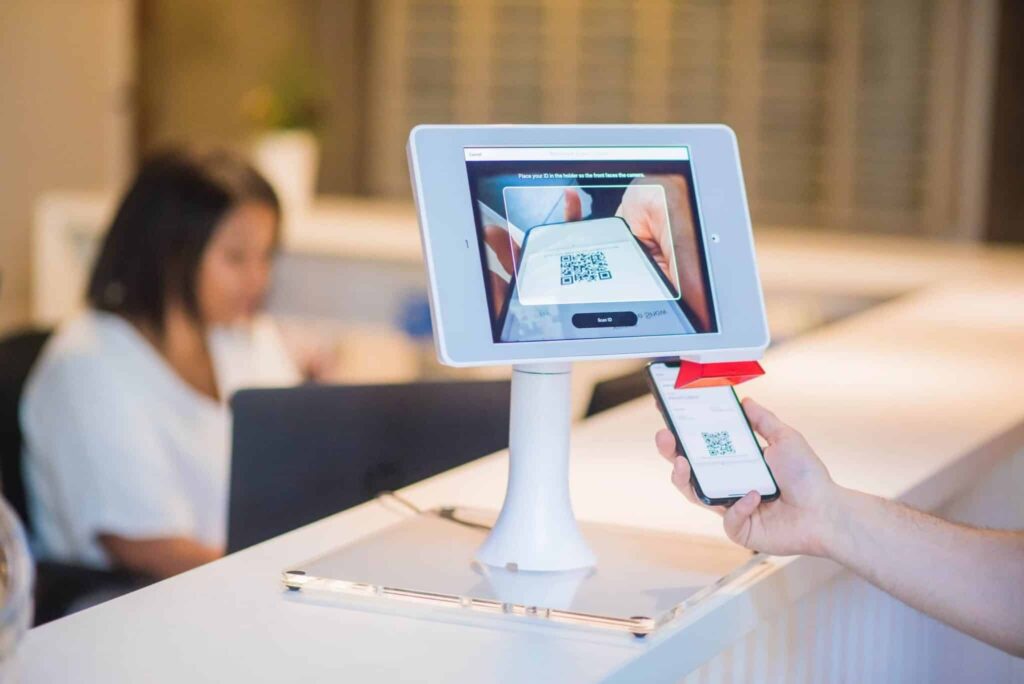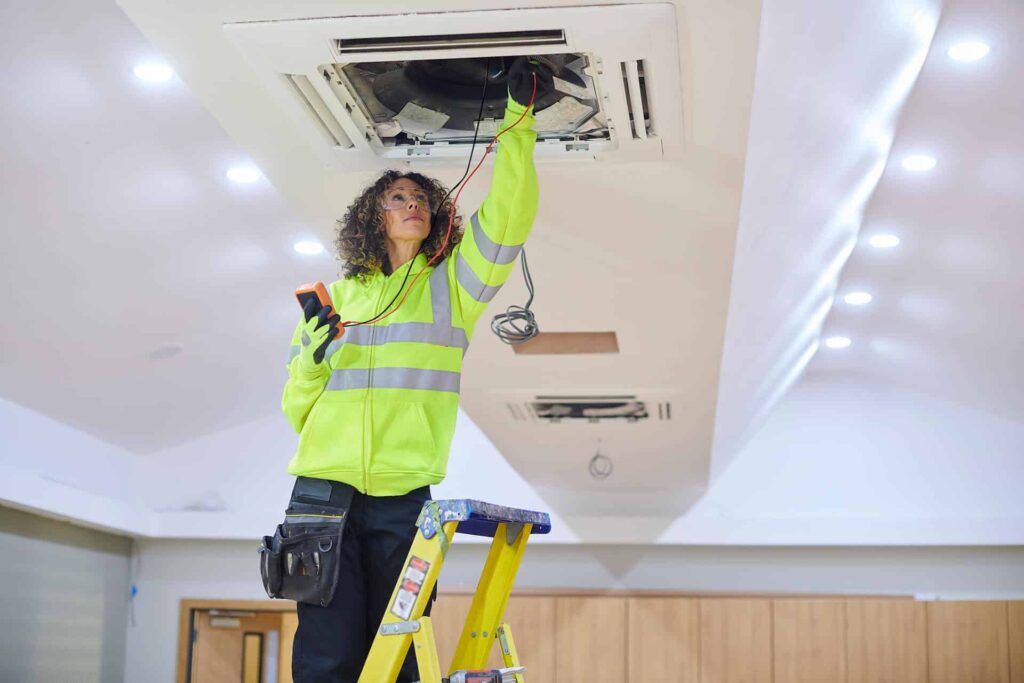The Role of Workplace Analytics in Successful Hybrid Work

The pandemic catalyzed a remote work revolution practically overnight. Hybrid workplaces have become the norm, with a blend of remote and in-office work emerging as a sustainable solution that supports employee flexibility and business continuity.
However, smoothly integrating hybrid work can be a challenge. To implement it successfully depends on your business’s ability to adapt its office environment to meet evolving employee preferences and space utilization needs. To gain data-backed insights regarding how best to configure your hybrid office, you need to implement workplace analytics.
Knowing how employees use spaces and collaborate is essential in order to support productive hybrid work. Workplace analytics inform operational decisions that optimize limited real estate to maximize productivity and cost savings. This allows you to retain the connectivity and company culture developed through onsite work while capturing the flexibility of remote work.
What is Workplace Analytics?
Workplace analytics refers to collecting and analyzing data about how employees utilize offices and collaborative tools. Analytics provide actionable insights to enhance efficiency, productivity, and employee experience in increasingly complex hybrid environments.
Definition and Scope of Workplace Analytics
Workplace analytics leverage data from sources like room booking platforms, employee surveys, WiFi connections, badge swipe access, sensors, calendars, and collaboration tools. Analyzing these inputs generates metrics around occupancy rates, space usage, collaboration patterns, and employee satisfaction.
Software dashboards contextualize the raw data into digestible visualizations and recommendations. Leadership can then tailor spaces, technology, policies, and budgets to how people actually work.
Importance of Data-Driven Decision-Making
Basing workplace updates on assumption rather than evidence risks wasting resources. For example, an organization might assume its finance team needs a dedicated space for head-down focus. However, sensors reveal that the team rarely uses the room allocated for this purpose. Instead, the data shows that the finance team needs to connect often with remote team members using a conference room fitted with video conferencing capabilities and other collaborative tools.
Workplace analytics allow you to see actual work habits and space usage in real time, giving you the information needed to adjust your office layout accordingly. In complex hybrid work environments with constrained real estate, accurate utilization data and analytics are prerequisites for adapting offices in effective ways.
Sign up to see Workplace Intelligence in action →
Collecting the Right Data
A wide variety of data sets and collection methods feed into workplace analytics platforms:
Employee Feedback
Annual or periodic surveys can gather employee perspectives on their hybrid experiences, preferred collaboration formats, and office needs. Collecting data about user preferences guides decisions around updating spaces, technologies, and policies.
Utilization of Smart Office Technologies
IoT sensors can track occupancy rates, space usage, and foot traffic analytics. Employee badge access systems reveal site entry patterns and occupancy. Device connections to WiFi or ethernet networks verify in-person attendance, while calendar integrations and room booking systems provide further information regarding space utilization and requirements.
Collaboration and Communication Platforms
Data from videoconferencing, messaging tools, or project management systems can help quantify virtual collaboration rates. This identifies spaces like huddle rooms that might be better served as hybrid meeting areas. Analyzing the usage of different platforms steers IT decisions around which tools and technologies employees actually leverage.

Practical Applications in the Hybrid Workplace
These data sets lay the foundation for analytics, revealing actionable insights around:
Understanding Employee Behavior
Evaluating survey feedback, sensors, and system usage helps assess employee preferences between remote versus onsite work. Leaders and facility managers can then develop supportive policies enabling employees’ desired flexibility.
Enhancing Office Layouts and Space Utilization
Data exposes under- and over-utilized areas to drive rightsizing initiatives. Workplace analytics clarify actual space needs so you can adjust your office layout to match what types of areas are actually being used.
Saving Money
Optimizing spaces for occupant requirements slashes real estate costs. Identifying and removing redundant tools and spaces based on data analytics indicating low usage allows you to get the most out of your budget.
Improving Efficiency and Productivity
Understanding peak occupancy patterns allows you to adjust staff attendance and scheduling to avoid overcrowding. Analyzing usage also guides investments around renovations, AV equipment, and new features that cater to hybrid work.
Benefits of Workplace Analytics
Workplace analytics provide numerous benefits to office and facilities managers looking to streamline their workspaces.
Informed Decision-Making
Guessing employee space preferences risks undershooting or overshooting actual needs. Data analytics provide leaders with empirical validation for any changes they make, ensuring those adaptations align with employee requirements.
Enhanced Employee Experience
These days, employees expect workplaces to cater to hybrid workflows. Implementing office configurations and technologies that facilitate flexible collaboration, seamless desk and room reservations, and comfortable work environments makes employees feel like their needs are heard and met.
Maximizing Operational Efficiency and Cost Savings
Eliminating underutilized spaces and right-sizing office footprints saves immensely on leases and energy bills. Optimized space management also minimizes disruptions and maximizes employee performance.
Workplace Analytics Tools
Analytics software like OfficeSpace digest large volumes of sensor, system, and survey data into dynamic and easy-to-use dashboards. Customizable visualizations, maps of room types, graphs displaying utilization peaks, and detailed reporting simplify the process of creating efficient action plans out of complex data sets.
IoT sensors deliver real-time monitoring capabilities alongside long-term data sets, so you can not only see how spaces are being used right now, but also identify long-term use patterns over weeks, months, and years. In addition, location analytics tools combine room reservation systems with occupancy tracking to visualize demand trends.

Workplace Analytics in Hybrid Work
While hybrid ecosystems create a number of new complexities to manage, data and analytics can simplify the transition. Here are a few examples of how workplace analytics can help solve some of the challenges posed by the hybrid work model.
Adapting Office Layouts for Improved Collaboration
Suppose you have a situation where hallway chatter, email surveys, and increased meeting room bookings indicate a need for more common spaces to hold spontaneous hybrid catch-ups. Analytics could then highlight underutilized open areas that can be converted to collaboration spaces and equipped with the appropriate connective technology.
Dynamic Desk Booking for Flexibility
If workplace analytics indicates 120% desk occupancy despite 60% office attendance, the problem might be solved by adopting hot-desking software. Sensor integration could then display open desks daily, better leveraging existing desks to accommodate hybrid fluxes.
Enhancing Efficiency through Resource Allocation
If peak occupancy spans 11am-2pm on Wednesdays according to WiFi timestamps, adjusting schedules can prevent overcrowding. Workplace data and analytics provide the insights you need to avoid making the costly decision to expand spaces rather than shift attendance.
Cost Savings Through Space Optimization
Should multi-year usage data indicate declining demand for personal desks due to remote work, you could eliminate an office floor to save money. Despite hybrid complexity, data analytics prevent over or underspending.
Employee Well-being and Work-Life Balance
Employee badge access patterns demonstrating frequent late nights may prompt you to reset security access to discourage unmanageable schedules.
Personalized Workspace Experiences
Leveraging metrics that capture preferred room temperatures, lighting, and desk ergonomics from sensors creates spaces catering to individual employee comfort.
Real-Time Monitoring for Immediate Adjustments
RFID locators amplify wayfinding for unfamiliar or occasional site users. Room dashboard displays also support shifting teams between spaces mid-meeting based on attendance fluctuations seen in real-time.
Building a Better Workplace Through Analytics
Business success hinges on using workplace analytics to translate data into supportive employee-centric adaptations. Metrics and sensors alone offer little without context, but using the right analytics solution provides meaningful insights to improve your hybrid ecosystem.
Organizations that utilize the right technology can create a workplace that helps employees re-learn productive hybrid work rhythms and constantly improves the efficiency of your spaces. With compassion and creativity, data-driven dynamic workplaces can flourish.



